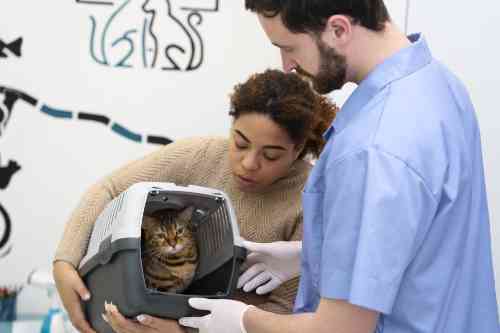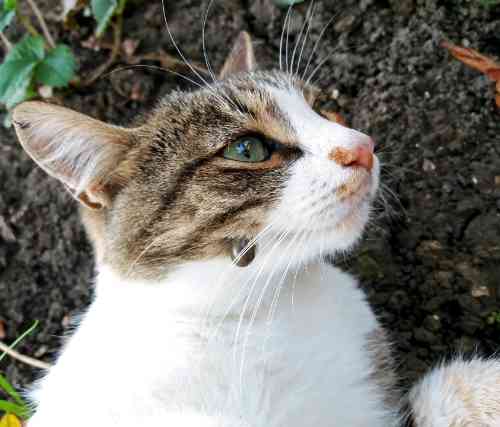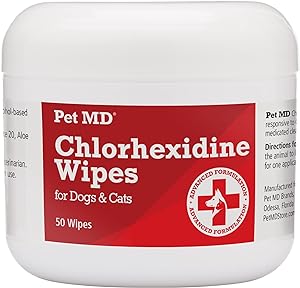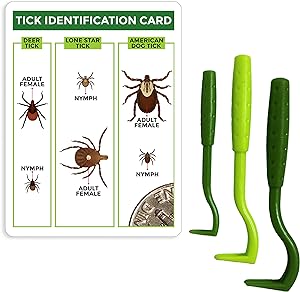Your cat has a bump on his tail
What could it be?
A bump on your cat’s tail can develop very suddenly, but can also grow over a few months. Bruises and abscesses are common, but we also find a cyst or a wart with some regularity. In this article we will tell you more about the possible causes of the bump on your cat’s tail and how to tell the difference between the various possibilities. We will also tell you about the possible treatments. So read on in order to help your cat.
What do we mean by a bump on your cat’s tail?
A bump on your cat’s tail can be described as a visible, palpable swelling that can vary in size and shape. The swelling may feel hard or soft and may be located anywhere along the length of the tail. The skin over the bump may have a normal appearance, but it may also be red, inflamed, or even open with visible discharge. This depends on the underlying cause. The bump may be painful when you touch it. Your cat can react quite strongly and sometimes aggressively.
Causes of a bump on your cat’s tail
There are several possible causes that lead to a bump on your cat’s tail. This could involve:
- bruise,
- infection or abscess,
- cyst.
- wart,
- broken tail
- tick
- tumor/cancer
Below we explain the different causes in more detail.
Bruise or trauma
If your cat has had an accident with his tail, the tail can swell considerably in one place. In that case his tail is bruised. A bump on his tail may in that case be felt. This bump usually develops within a few hours and can be quite painful, but it isn’t always the case. Sometimes you also see some abrasions or some hairs have disappeared. However, your cat will never have a fever and will have a normal appetite. Sometimes he can hold his tail a little lower than you are used to from the pain.
Infection or abscess
If a puncture wound has occurred on your cat’s tail, bacteria may have been left behind under its skin. These bacteria will multiply and your cat’s body will respond to this infection by, among other things, sending pus cells there. These pus cells clear away the bacteria. However, if this does not work quickly enough, more and more pus cells continue to come to the area. The result is that a cavity is created that is filled with pus. We call this an abscess.
In most cases, an abscess occurs as a result of a fight with another cat in which a nail or tooth pierces the skin. An abscess usually develops in about 2-3 days and it can cause your cat a lot of pain. In addition, a cat often has a fever and might be less eager to eat due to the fever. After about 3 days the abscess bursts and a lot of smelly, purulent and often bloody mess comes out. It may look dramatically bad for an owner, but your cat will feel a bit more comfortable at that moment because the pressure from the abscess has been removed and the pain has therefore decreased considerably. You can read more about this problem on the page about an abscess on the tail of your cat.
A cyst
A cyst is a bump in the skin that is filled with fluid or sebum. The skin contains several small glands that produce moisture or sebum. When the drainage duct of these glands becomes clogged, a bump on your cat’s tail may become noticeable. This cyst develops over the course of months and your cat almost never suffers from it. So he doesn’t lick it and the skin looks calm. Even when you gently squeeze it, your cat usually does not respond. The bump often feels a bit firm, but not as hard as bone. You will also feel that the bump has a clear border and is not gradually becoming less thick.
A wart
Small skin bulges may occasionally develop in older cats. We call this a wart. A wart always grows from the top layer of the skin and is therefore always on the skin and never in or under it. No hair grows on them and they are a maximum of 2 to 3 millimeters in size. They grow very slowly and usually don’t bother your cat much. Sometimes they can get a little irritated and become a bit red or look dirty.
A broken tail
If the tail vertebrae do not run in a nice straight line, there is a fracture or a deformity in the tail. Has the fracture occurred recently, it will be quite painful when you touch it. If the bump has been present for much longer, your cat will no longer experience pain. In that case, the fracture has already healed and grown back together in the wrong position.
A tick
Actually, a tick doesn’t really belong on the page over a bump on your cat’s tail. However, in practice it happens so often that people consult a veterinarian because they have felt a bump on their cat’s tail and it turns out to be a tick, that we will mention it here. A tick is a parasite that belongs to the arachnids. It attaches itself to the skin of a mammal and sucks blood there for food. Females in particular can grow very large because they are making a lot of eggs in their abdomen with that blood.
A tumor or cancer
Several types of tumors have been described in cats. Both benign and malignant (= cancer). However, in practice it is very rare for a cat to have a cancerous tumor on his tail. Depending on the sort, a tumor will grow in a few weeks to a few months or even years. It may irritate your cat a lot, but it doesn’t have to. They can grow through the skin, but can also be very clearly defined. Especially when they grow quickly, the color of the skin is abnormal, your cat suffers a lot from it or open wounds develop on the tumor, this is an important reason to take your cat to your vet. They can conduct further investigations if necessary, to find out exactly what the bump on your cat’s tail is and whether it needs to be treated to have a better chance of survival.
How do you diagnose the bump on your cat’s tail?
That can sometimes be a challenge as an owner. In any case, it is important that you consider how quickly the bump on your cat’s tail developed. If this has occurred within a few days, it is wise to measure his temperature. When his body temperature is below 102,5 degrees, there is no fever. If he has a fever, then it is an abscess.
You also need to try to estimate how much irritation your cat is having from the bump on his tail. Does he lick it a lot? Then there is a high chance of a bruise or trauma. Does he not lick it much and is the bump very clearly rounded? Then it is probably a cyst.
Is the bump on your cat’s tail mainly on top of the skin and not inside? And is it only a few millimeters in size? Then it is most likely a wart. Or a tick, that is also possible. So take a good look to see if the part that is attached to the skin has small black legs. If necessary, grab a magnifying glass so you can see it clearly.
Is it mainly a hard, bony bump on your cat’s tail? Then he has a broken tail. If your cat is not in pain, this fracture has healed already.
Tumors and cancer are often difficult to recognise. Fortunately, it only occurs very rarely on a cat’s tail. But do you see that the bump has a clear black or gray color or that it grows out through the skin? Or does it have a very irregular shape? Then there is a chance that it is a tumor or cancer. A vet can do more research to find out.
Do you need to treat a bump on your cat’s tail?
Whether you need to treat a bump on your cat’s tail depends on the cause. Below we explain per cause what the treatment can be and whether this is really necessary.
A trauma or bruise
If you suspect that your cat has a bruised tail, this will in principle heal on its own. This usually takes 1-2 weeks. However, you should not see any wounds on the bump on your cat’s tail and your cat should otherwise be fit and lively. His tail should also not be in a kink. If this is abnormal, it is better to take him to your vet. If necessary, he or she can conduct further tests or give your cat a painkiller.
An abscess
In most cases, an abscess will burst open on its own after 2-3 days and then heal. As long as your cat does not appear extremely ill, you can treat it at home. On the page about an abscess on your cat’s tail you can read what you can do about it yourself.
However, is your cat quite sick and eating poorly? Then it is better to take him to your vet. This can open the abscess and administer a course of antibiotics. Your cat will also receive a painkiller and fever reducer. With the help of this medication, he will usually start to improve considerably within 24 hours.
A cyst
As long as a cyst does not irritate your cat, you do not need to treat a cyst. If the cyst becomes a bit dirty, you can clean it with disinfectant chlorhexidine wipes.
If the cyst does become a bit infected, you can initially try to resolve the inflammation with honey ointment. You then apply this to the bump 3 times a day. Typically this is only necessary for 7-10 days.
Is the cyst on your cat’s tail still a bit unsettling? Then it is better to take your cat with that bump on his tail to your vet.
A wart
In principle, a wart does not need to be treated as long as your cat does not suffer from that bump on his tail. But here too, you can clean it with chlorhexidine wipes or rub it with honey ointment if it bothers your cat. If your cat continues to suffer from it, it is better to visit your vet.
A tick
Does the bump on your cat’s tail turn out to be a tick? Then it is wise to remove it as quickly as possible. You do this with a tick remover. There are different types and sizes, so decide for yourself which one you like best. Below we give you three commonly used tick removers.
You should not anesthetize a tick with alcohol beforehand. If you do this, the tick will empty its stomach in your cat and can inject all kinds of diseases into your cat. You should also ignore the myth that you have to turn the tick counterclockwise or clockwise. Turn the direction you like. But don’t just pull it off. By turning, the tick releases itself.
Although it is theoretically possible for cats to also contract transmissible diseases from ticks, in practice this rarely appears to be the case. Cats seem to have some kind of natural defense against these diseases. For example, the chance that your cat will contract Lyme disease from a tick is very low. However, it is not wise to gamble on it and anesthetise the tick with alcohol. There’s really no need to do that.
A broken tail
On the page about a broken tail in a cat you can read what you can do or have done in this case. However, if the bony bump on your cat’s tail is old, there is no need to treat it. Your cat will no longer be bothered by it and can have a good life with it.
A tumor or cancer
Do you suspect that your cat is one of the unlucky ones that has a tumor or cancer on his tail? Then a visit to your vet is necessary. This can use a needle to remove some cells from the bump on your cat’s tail and have this examined in a laboratory. In the case of lipoma’s, your vet will usually be able to examine this immediately in practice. A lipoma does not require further treatment unless it becomes too large. Other forms of tumors or cancer can be removed surgically. In very aggressive forms of cancer, it is often decided to amputate the entire tail to limit the risk of future metastases as much as possible. If necessary, chemotherapy or radiation may also be necessary. But not everyone chooses this option.
Keep a close eye on the bump on your cat’s tail
Have you decided that the bump on your cat’s tail does not need to be examined by a veterinarian at this time? In any case, make sure that you keep a close eye on the bump yourself. Try to measure it and track its growth. And also keep a close eye on whether you see your cat licking or biting it a lot. If in doubt or in case of rapid growth, it is better to have the bump on your cat’s tail assessed by a veterinarian.
The story of cat Bella and the bump on her tail: a case study
Information
Bella, a 5-year-old spayed British Shorthair, had a slow-growing bump on her tail that grew larger over several months. Bella is an indoor cat with occasional access to an enclosed garden. Her owner noticed that Bella had no signs of pain or irritation to the bump on her tail, such as licking or biting. Still, her owner wanted some advice from our vet Nanda to decide whether it was better to visit the veterinarian near by.
Contact with veterinarian Nanda
During the WhatsApp conversation, Nanda asked several questions to determine how the bump felt and how big it was. Photos and videos were also exchanged. In Bella’s case it turned out to be a clearly defined bump of about 1 cm in size. It felt a bit hard, but not as hard as bone. The bump was in the middle of the tail, at the upper side.
Diagnosis process
Based on the WhatsApp conversation, veterinarian Nanda could not be completely certain that it was a cyst. It looked very similar considering the size and location. But the color was just a little too dark for a cyst. That is why the owner was advised to visit the vet to be sure. The local vet also had some doubts about it and decided to puncture the bump on Bella’s’ tail with a needle. Of course, the bump was first disinfected with alcohol before it was punctured. Watery fluid was very easily sucked out of the bump and the diagnosis of a “cyst” became definitive.
Treatment plan
Since the cyst did not cause any discomfort or irritation for Bella, it was decided not to treat the cyst but to continue to monitor it. The cyst has now been drained, but will fill again in the upcoming weeks. However, this can’t hurt. Typically, the cyst stops growing when it reaches 1-2 centimeters in size. If Bella starts to suffer from the bump on her tail, the bump can easily be removed surgically under anaesthesia. But this is not necessary yet.
Good luck with the bump on your cat’s tail!
Hopefully, this article and Bella’s story have given you enough information to make a good diagnosis about the bump on your own cat’s tail. We wish you and your cat the best of luck and hopefully you can leave the lump there without causing any harm.











